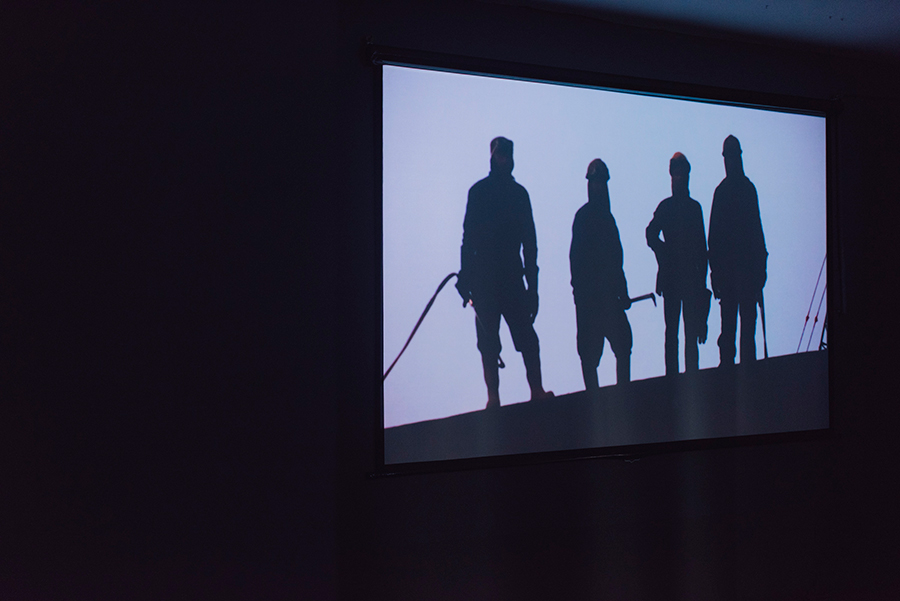What Can We Learn From Water?: A Report from Colomboscope
The sixth edition of the Sri Lankan arts festival uses the sea to press issues of migration and gentrification, climate change and the future of labour in the wake of automation
The sixth edition of the Sri Lankan arts festival uses the sea to press issues of migration and gentrification, climate change and the future of labour in the wake of automation

By the time I arrived at ‘Sea Change’, the sixth iteration of Colomboscope arts festival, I had already spent a fortnight travelling through Sri Lanka. The sway of the palms had entered me; island time swirled around my ankles. I made my way to Barefoot Gallery, where Bangladeshi photographer Shadman Shahid’s unframed, black and white series ‘Another Day in Paradise’ (2016) provided a stark contrast to both my mood and the up-tempo jazz playing in a cafe outside. These works grasp at a dark, deep, complex melancholy. A man sits on a plastic chair on a beach in fins, a mask and a snorkel tube. He looks downwards, as if to the depths of the ocean floor. In another photograph, a man sits in a kurta and a sarong with a falcon on his shoulder. A turtle is washed up on shore, its shell cracked. A little girl lies asleep, mermaid-like, on a rock near the water, draped in silks. Light stems from unexplained sources and darkness reveals loss. Ecological catastrophe is in close proximity to the occult. Multiple systems of knowledge make up this fragile ecosystem.
Curated by Natasha Ginwala, the festival uses the Rio Cinema as its primary venue. Part forgotten hotel, part functioning but outwardly derelict adult cinema, the Rio is located in a neighbourhood known as Slave Island after its original inhabitants, the African slaves of Dutch and Portuguese colonizers. The area still teems with African, Indian, Javanese, Burgher, Moor and Malay heritage – as evidenced in the food and architecture. A dark cloud looms: Slave Island is destined to be redeveloped and turned into a monoculture of apartment blocks. Another jolt to my reverie: the seven-storey Rio building was looted during the 1983 riots, when a mixed group of Sinhalese and Tamil-speaking Muslims robbed the hotel and set it on fire. Colomboscope has not concealed this history by whitewashing the walls or repairing the chipped wooden floor slats. Instead, the art and the building form a palimpsest of meaning, such that the country’s most recent state of emergency – declared in March 2018 after days of violence between Sinhala Buddhist and Muslim communities in the central city of Kandy – felt as though it were still seeping through the cornices.

The exhibition at Rio, which includes works by 35 artists (20 of whom are Sri Lanka-based), engages with the ripples and tides of maritime life: lost corals, eroding seabeds, material and ideological transfers, cultural confluences. Of these, Fazal Rizvi’s These Fissures in the Deep (2019) and Hira Nabi’s A Ship’s Story (2018) imagine links to shores not so far away and new possibilities, even in grave erasures. From the windows where Rizvi’s sound piece is set looms the Lotus Tower: a telecommunications skyscraper financed by China and designed to be the tallest self-supported structure in South Asia, whose endlessly deferred completion is reflective of the Sri Lankan government’s socio-economic hubris. Looking out towards the skyline, I donned headphones to listen to These Fissures in the Deep and was transported to a blueprint deep underwater, on a viscous journey amid jellyfish and sapphires. We hear water, air, footsteps. ‘What happens to objects that drown to never emerge? Bodies that are made to drown […] What forms do their non-forms take?’ Rizvi asks. It is a moving ode to all that has gone missing in the vastness of the ocean and a testament to the power art has to resurrect these objects, ideas and bodies.
Set in Pakistan’s Gadani shipyard, Nabi’s film is a heart-wrenching tribute to ship-breaking labourers: ‘Our wages prevent us from dying,’ one worker says, ‘but don’t allow us to live either.’ A woman narrator, in the guise of the ship’s voice, provides an oblique, poetic perspective on mortality. Nabi’s cinematography emphasizes the sheer quantity of assembly lines: rungs of ladders, chains, broken parts of metal, queues of men.

Other notable works include The Many-Headed Hydra’s installation, Seawater to wash the borders, salt in the wound, and zine, Rituals for dis-identification (both 2019), which examine queerness and ocean futurisms by way of screenprints of oracle hands and a growing series of conversations. Luka Alagiyawanna’s Ocean Cyanotypes I – X (2018) traces washed-up plastics, while Eternal Tides (2018), an album compilation on wireless headphones produced by Utsa Collective, can be listened to whilst navigating the building. There was, however, a great diversity of tone in the works on show, with some veering toward the literal, while others operated within far richer metaphorical contexts.
‘Sea Change’ emerges as a festival asking some of the most pressing questions in the region: about migration and gentrification, climate change, the future of labour in the wake of automation. There was an abiding sense that the festival will continue to push itself towards greater conceptual realms, reflecting on what we, as humans, can learn from water.
'Colomboscope' was on view at various venues in Colombo, Sri Lanka, from 24 until 31 January 2019.
Main image: The Many Headed Hydra, Seawater to wash the borders, salt in the wound, 2019, installation view. Courtesy: the artist; photograph: Ruvin de Silva
























